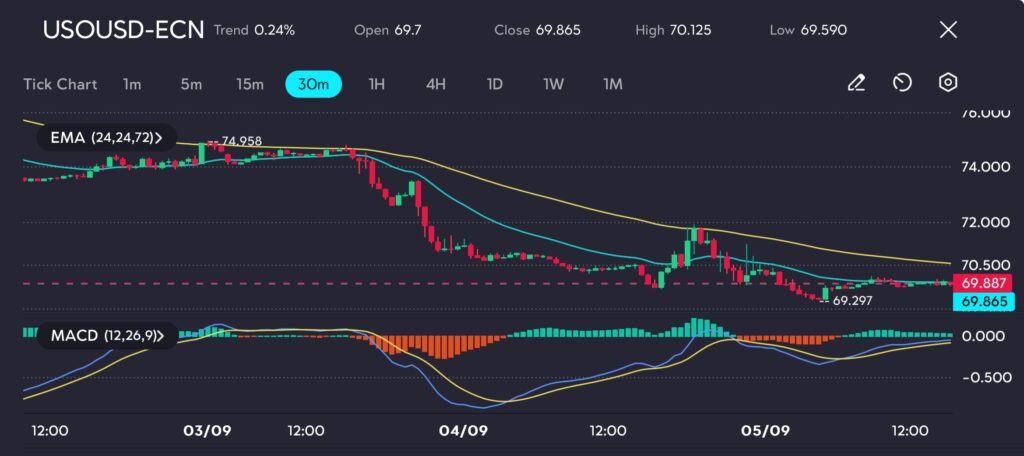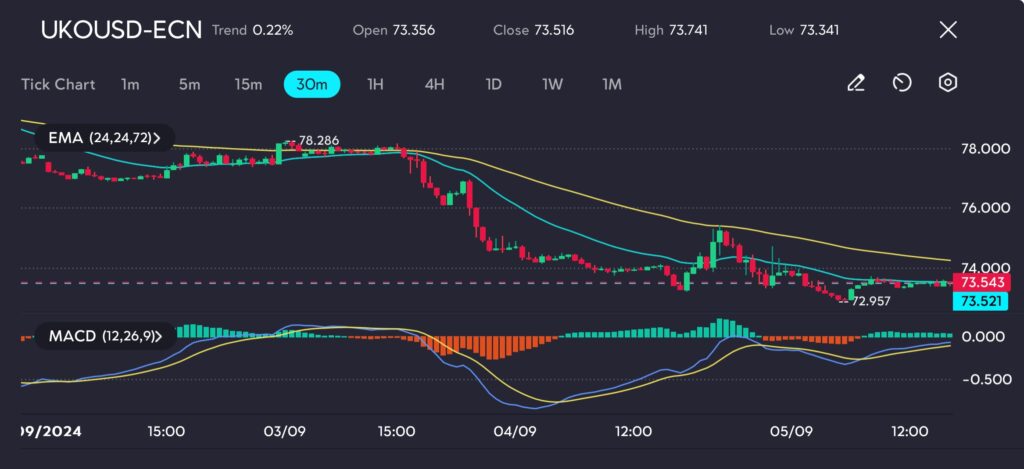Key points:
- Brent and WTI oil prices remained mostly flat after an overnight sell-off.
- OPEC+ may delay its planned production increase for October due to demand concerns.
- Chinese factory data showed the slowest activity in six months, affecting global oil demand.
Oil prices remained mostly flat after a sharp sell-off earlier in the week. Brent oil prices (Symbol: UKOUSD) rose to $72.79 per barrel, and U.S. West Texas Intermediate (WTI) (Symbol: USOUSD) climbed to $69.32 per barrel.


Picture: Oil prices laying flat after an overnight sell-off, as observed on the VT Markets app.
Both benchmarks had suffered losses pressured by weak demand from China and the potential for increased output from OPEC+ in October. Traders are now carefully evaluating whether the supply increase planned by OPEC+ will materialise, as the group faces pressure from a softening global economy and lower-than-expected demand from China.
OPEC+ supply decisions in focus
OPEC+ had initially planned to increase oil output by 180,000 barrels per day in October, continuing the unwinding of previous cuts.
However, with Brent and WTI recently hitting multi-month lows, sources within the group have suggested that OPEC+ may reconsider its production strategy. A similar move in April 2020, when demand collapsed due to the pandemic, saw OPEC+ implementing deep cuts to stabilise the market.
If OPEC+ delays its planned output hike, it could offer short-term relief to oil prices. However, the decision will likely hinge on continued demand softness, particularly from major importers like China.
Economic demand uncertainty in China
The state of the economy in China continues to cast a long shadow over the oil market. Over the weekend, China released data indicating a contraction in its factory activity for the fourth straight month in August.
The slowdown has raised red flags for global oil demand, as China is the world’s largest crude importer. Factory gate prices have tumbled, and Chinese manufacturers are struggling with declining orders.
U.S. crude oil inventories
On the supply side, U.S. crude inventories dropped by 7.431 million barrels in the last week, according to API data, far exceeding expectations of a 1-million-barrel draw. Despite the sharp inventory decline, concerns over weakening U.S. demand are weighing heavily on the market. June’s oil consumption in the U.S. hit its lowest seasonal levels since 2020, adding to the uncertainty over future demand.
The U.S. Federal Reserve’s interest rate decision in September is also a key factor influencing oil market dynamics. Lower interest rates typically boost economic activity and oil demand. With some market participants expecting a rate cut as large as 50 basis points, traders will be watching closely for any signs of improved economic growth.
Market outlook and opportunities
The potential delay in OPEC+ output hikes offers room for a near-term price rebound, especially if Chinese demand shows signs of stabilisation.
However, traders should brace for volatility as weak demand signals from China and the U.S. persist, as key economic data, including U.S. job reports and Chinese manufacturing numbers, are all key components in oil trading.









